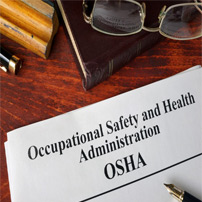The Dangers of Unguarded Machinery
August 1, 2017 The Occupational Safety and Health Administration (OSHA) recently issued 12 safety citations to a Florida electrical cable company after a 26-year-old machine operator lost his life in a fatal work accident. OSHA found that the company failed to provide adequate safety measures to protect the worker’s life, such as properly guarding machinery as well as failing to utilize control procedures, which would prevent machines from operating while being serviced by employees.
The Occupational Safety and Health Administration (OSHA) recently issued 12 safety citations to a Florida electrical cable company after a 26-year-old machine operator lost his life in a fatal work accident. OSHA found that the company failed to provide adequate safety measures to protect the worker’s life, such as properly guarding machinery as well as failing to utilize control procedures, which would prevent machines from operating while being serviced by employees.
This recent death highlights serious safety concerns in workplaces that occur far too often. Too commonly, these violations result in serious or fatal injuries, which could have been prevented. Machine safeguards are used for this very purpose: to keep workers safe from exposure to identified workplace hazards.
Machine safeguarding is any type of precautionary safety device that is used on engineering or manufacturing equipment to aid against injury. One example of a machine safeguard is a shield that protects employees from contact with dangerous machine parts. Often, machine safeguarding is considered as the first line of defense against a workplace injury caused by industrial machinery.
According to OSHA’s guidelines, all employers are legally responsible for safeguarding machinery in a workplace before any employees use or service it. If a machine does not come equipped with safeguards, employers must purchase them from after-market or original manufacturers and have professional technicians install them.
The most common causes of workplace machine injuries are impact, contact, entrapment and ejector accidents. When an employer fails to install machine safeguards, contact and entrapment accidents may occur. Contact accidents happen when a worker comes into contact with machinery parts, such as electrical equipment or sharp edges. Entrapment accidents can include when a worker’s limb is pulled into a machine. Impact and ejector accidents are when moving equipment hits a worker or a part is unsecured on a machine and flies off, hitting an employee.
As a result of different types of workplace machinery accidents, the most common injuries that workers sustain include amputation, blindness, burns, head injuries, lacerations, cuts, eye injuries, electric shock, broken bones, loss of limbs and damaged nerves and tendons. All of these injuries can result in time lost from work, workers’ compensation or social security claims, medical bills and a loss in quality of life. Sadly, many of these injuries can result in injuries so catastrophic that they are fatal.
OSHA’s rule of thumb when it comes to machine safeguarding is that employers must protect against: “any machine part, function or process which may cause injury” to workers. Because injuries can occur in a variety of ways, machine safeguards should meet certain requirements that help decrease the chances of them occurring. Some of OSHA’s basic machine safeguard requirements are listed below:
- Protect workers from falling objects and ensure that objects cannot fall into machine’s moving parts;
- Prevent bodily contact with the machine from occurring, and;
- Secure safeguards in place so that workers cannot tamper with or remove them.
As an employee, it is difficult to know what all the legal responsibilities of an employer are – and it is not the job of an employee to make sure that his or her boss is taking the proper precautions to ensure a safe workplace. Employers should know what their legal obligations are, and make sure that they meet them all adequately so that workers are protected against workplace injuries and deaths. Some of the most basic employer responsibilities, according to federal regulation as mandated by OSHA, include:
- Providing a workplace that is free from recognized hazards and complies with OSHA rules and regulations;
- Making sure employees have safe equipment and tools, and;
- Properly maintain all work equipment.
Employers are legally required to abide by many other safety standards. If you have any questions or concerns about workplace safety or machine safeguarding and would like to speak with an attorney, a member of our team can help you.
Philadelphia Work Injury Lawyers at Galfand Berger, LLP Fight for Injured Workers in Pennsylvania
If you or a loved one has been injured at work because of an unsafely guarded or unguarded machine, please call Philadelphia work injury lawyers at Galfand Berger at 800-222-8792 or contact us online. We have been helping injured victims throughout Pennsylvania and New Jersey for more than 65 years.
 Google Screened
Google Screened
